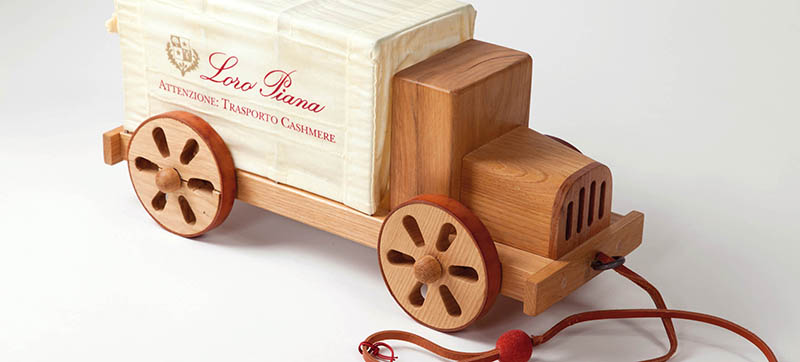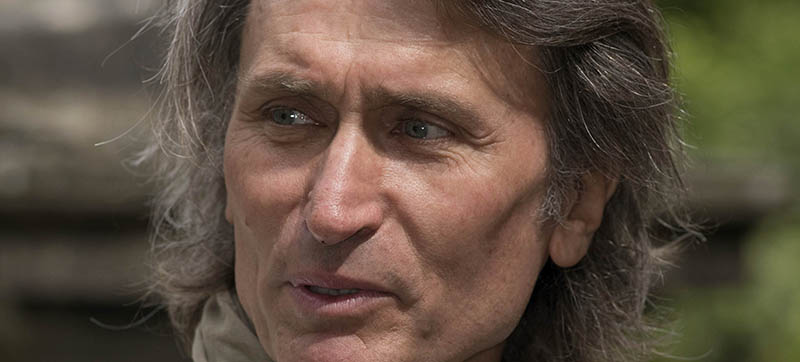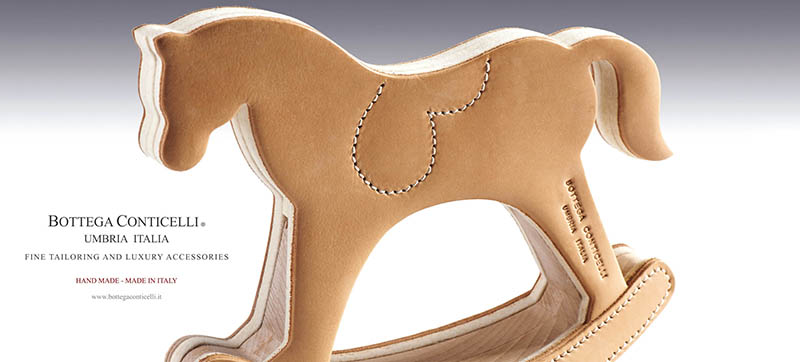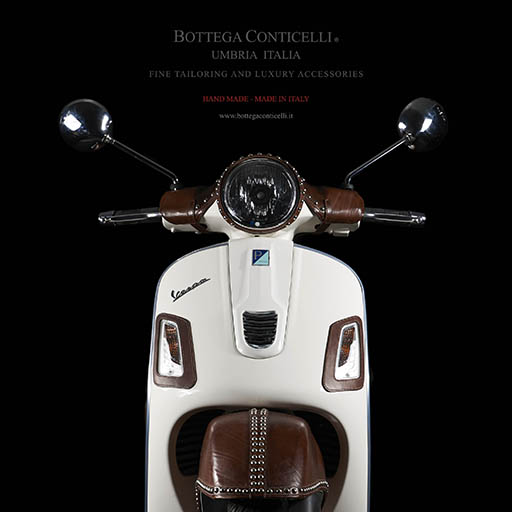THE INTERVIEW/ Stefano Conticelli
by Roberta Olcese
When he describes his creations he transforms into a river in full flow. When you listen to him a whole host of images of wooden toys, little toy airplanes and rocking horses covered in odd-shaped cashmere blankets flit quickly before your eyes. Then, there are the bicycles, the Vespa scooters and original Fiat 500’s, all rigorously upholstered and made so unique by the high quality of the leather and the materials used. When you look at them you’ll want to order one immediately even when you know that delivery times are slow, as slow as the very seasons themselves.
The objects that take shape in Stefano Conticelli’s hands are real works of art that are commissioned for the noblest of homes and the most aristocratic of names, from the shops of Loro Piana to the corner shops in the rooms of the Senate in Rome. “My story has been like a fairy-tale. I only have to follow my life’s path and be led around the world, pulled by the inexhaustible positive energy of a little toy lorry”.
Just like a miracle worker, Stefano Conticelli mixes art, talent and intuition. When you listen to this “fairy-tale” of his you become immersed into the workshop where his ideas are born, the “lifestyle” of the Conticelli bottega – one thousand square metres of open space in the heart of Umbria in central Italy.
Now, after years producing objects for the most important brand names in luxury, this craftsman from Umbria has decided to launch his own brand and create an itinerant bottega, a sort of moving workshop.
Stefano, what’s the strength behind the Bottega Conticelli?
When you walk into the bottega, what actually strikes you isn’t the single object but the world that’s opening up before you, just as if you were entering into a world where everything is made of magic. This next May will be the eighth anniversary since our debut but it seems that fifty years have passed by if you take into consideration the amount of progress we have made together and the sudden and unexpected success we have enjoyed. We have made some incredible contacts – many by pure chance – and we have almost become a sort of a byword among the clients we have made, customers who are looking for the highest degree of sartorial refinement and the uniqueness of a single product. Nowadays, with globalisation companies have lost much of their identity.
Can you tell us how it all began?
I’m self-taught. I possess a certain spontaneous and very special affinity with leather. I am lucky enough to understand and “comprehend” any material whatsoever and to get the best out of it, just as we do with people. I can easily trace the right grain or veining in woods and marble. I am able to recognise the fineness of textiles and I can work successfully with them. I have this particular gift. I leave my own mark on all that I create and this fact I consider to be something exceptionally precious to know.
And your bottega?
The company grew out of the little “lorry” for Loro Piana. At forty-four years of age I suddenly found myself out of a job and this was an absolute tsunami, as you might imagine. I started by collecting the leftovers from sawmills. I put back together the different woods, I cleaned them up so I could make mirror frames out of them which I sold in the markets in Rome and Florence. People liked my creations immediately. They had clean lines and were highly essential in taste. Yet, they struck people for their degree of sophistication. So, I bucked up a certain amount of courage and I set myself up in a cellar at home. One day, my little nephew and nieces passed by, Rachele, Valentina and Tommaso. I gave my nieces a little duck on wheels whilst I promised my nephew a little lorry for his birthday. I built the lorry passionately and on its coarse cloth top I wrote: “Tommy Trasporti Palermo-Napoli-Milano-Venezia-Torino”, just like you used to read on lorries in the past. On my nephew’s birthday I arrived with my little lorry and all of a sudden all of the friends who had been playing with their Play Stations started to play with Tommy’s new toy. That night, Tommy took his new toy to bed with him just like a teddy bear. So, I thought: this little boy is sending me a message! I immediately wrote to two magazines telling them about the story. “Hello, is it possible that an eleven-year old boy gives up an electronic game for a little lorry made of wood and coarse cloth?” The monthly magazine, Dove, understood the message and put Tommy’s little lorry on the front cover. Then, the interviews and the orders all began. I have even kept a register of the whereabouts of my little lorries: number 300 went to the young Prince Jacques of Monaco while number 301 belongs to Aldo Wannenes in Genoa.
How did Loro Piana come along?
It’s all thanks to my sister who gave a lorry to Vittoria, Sergio and Luisa Loro Piana’s daughter. They loved the present and soon after asked for another one for their other children, Pietro and Margherita. I created a special parcel and gave it to them. When Sergio later commissioned further little unique lorries for his shops with the writing, “Loro Piana Attention Cashmere Transport”, I realised I had created something that was apparently simple but, in substance, quite exceptional! Demand rapidly grew and fanned out into carpets, board games, helicopters and airplanes, all clothed in cashmere.
What has this experience given you?
Lots of new contacts and tons of new stories. Once, a prince from England, after having seen one of my lorries in New York, contacted me to order one but wanted his butler to be present when the lorry was made. And all the way he came over, too. To make sure that it was all hand-made from a single piece of wood. Then, there was the story of the Swiss woman who was struck my the sewing on the two leather door handles for the Loro Piana shop in Gstaad. She called me to furnish her yacht with carpets and an especially sewn haute couture white optic blanket. A one-off – she treats it like a baby.
One of your Bottega’s main products is its “Vespa”. How did this particular idea come about?
This, too, all came about by chance. A friend of mine asked me to personalise his Vespa scooter. I took six months to do the first bit what with pasting, cutting and sewing. It’s very difficult to “customise” the handle-bar of a Vespa. You need to turn a piece of leather round three hundred and sixty degrees. At present, I am the only one in the workshop who can do it. You need both the strength of the hammer and the softness of water to open up the pores of the leather. And the sun and the northerly wind to dry it. One Christmas during an event for the Riva boatyard at the Yacht Club in Monaco a personalised Vespa was ordered. I explained the complexity of the operation immediately and therefore the impossibility to establish any sort of delivery date: leather only dries in the air, not in the oven. In winter, you need the northerly winds and that was a particularly warm winter. The customer had his Vespa at the end of April. Luckily, he waited for me!
It gave you satisfaction, though.
Indeed. We exhibited it at the Triennale in Milan during the Furniture and Design Fair and afterwards we were asked to customise some chairs by Philip Stark.
Something crazy ever happened?
I once pursued Princess Hanya of Jordan, Queen Rania’s sister-in-law, at a horse-race in Villa Borghese in Rome. I wanted to give her a bag – exclusively created for her – in the shape of a saddle knowing, as I did, her love of horses. She loved it and many others followed.
Do you consider yourself to be an artist?
I undertake my work with passion and love. I would like to transmit emotion. I am also setting up an archive with my most important works. Above all, though, there’s the study of techniques and materials that I am continually doing. I experiment with metals, from bronze to iron and silver. I also take into my workshop other materials like plastic, jute and natural synthetic materials like silicon. I undertake experiments with fusions and my work becomes one long and constant discovery. I love glazes: my first job employing this particular technique was an enormous teapot in porcelain for Asprey’s in London.
What plans have you got for the future?
An itinerant bottega. Maybe on a ship where I can change ports every six months. I would like to find a partner; a ship owner, maybe. A dreamer like me. Next summer we’ll be in Porto Cervo. We’ll be staying in a three hundred square metre space. This is just the beginning.







